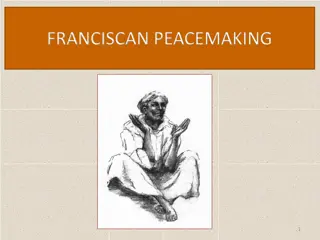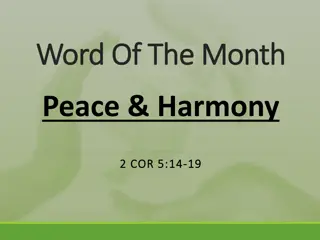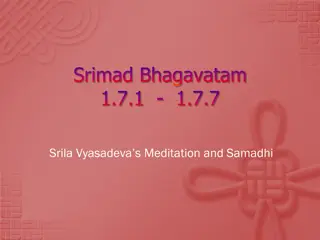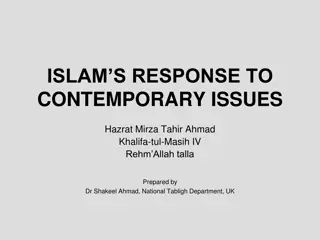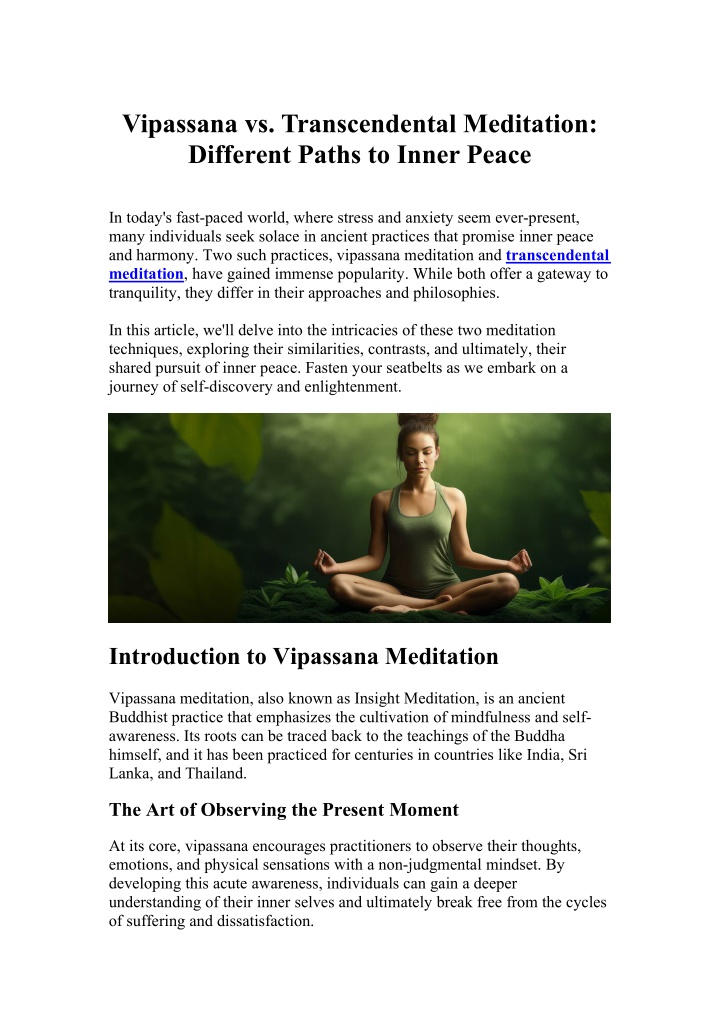
Vipassana vs. Transcendental Meditation Different Paths to Inner Peace
The article discusses Vipassana meditation and Transcendental Meditation (TM) as pathways to inner peace. Vipassana, rooted in Buddhist tradition, emphasizes mindfulness and observing present experiences without judgment. TM, popularized by Maharishi Mahesh Yogi, involves repeating a mantra to reach a state of pure consciousness. While both aim for inner tranquility, they differ in technique, tradition, and approach to thoughts. Benefits include stress reduction and increased self-awareness. Choosing between the two depends on personal preference and guidance.
Download Presentation

Please find below an Image/Link to download the presentation.
The content on the website is provided AS IS for your information and personal use only. It may not be sold, licensed, or shared on other websites without obtaining consent from the author. If you encounter any issues during the download, it is possible that the publisher has removed the file from their server.
You are allowed to download the files provided on this website for personal or commercial use, subject to the condition that they are used lawfully. All files are the property of their respective owners.
The content on the website is provided AS IS for your information and personal use only. It may not be sold, licensed, or shared on other websites without obtaining consent from the author.
E N D
Presentation Transcript
Vipassana vs. Transcendental Meditation: Different Paths to Inner Peace In today's fast-paced world, where stress and anxiety seem ever-present, many individuals seek solace in ancient practices that promise inner peace and harmony. Two such practices, vipassana meditation and transcendental meditation, have gained immense popularity. While both offer a gateway to tranquility, they differ in their approaches and philosophies. In this article, we'll delve into the intricacies of these two meditation techniques, exploring their similarities, contrasts, and ultimately, their shared pursuit of inner peace. Fasten your seatbelts as we embark on a journey of self-discovery and enlightenment. Introduction to Vipassana Meditation Vipassana meditation, also known as Insight Meditation, is an ancient Buddhist practice that emphasizes the cultivation of mindfulness and self- awareness. Its roots can be traced back to the teachings of the Buddha himself, and it has been practiced for centuries in countries like India, Sri Lanka, and Thailand. The Art of Observing the Present Moment At its core, vipassana encourages practitioners to observe their thoughts, emotions, and physical sensations with a non-judgmental mindset. By developing this acute awareness, individuals can gain a deeper understanding of their inner selves and ultimately break free from the cycles of suffering and dissatisfaction.
The Transcendental Meditation Technique Transcendental Meditation (TM) is a practice that originated in India and was popularized in the West by Maharishi Mahesh Yogi in the 1950s. Unlike vipassana, which focuses on mindfulness and observation, TM involves the repetition of a personal mantra, or a specific sound or word, to achieve a state of transcendental consciousness. Effortless Transcendence Proponents of TM believe that by silently repeating the mantra during meditation, the mind naturally settles into a state of pure awareness, transcending the boundaries of thought and attaining a profound sense of relaxation and inner peace. The Contrasts between Vipassana and Transcendental Meditation Despite their shared goal of inner tranquility, vipassana and transcendental meditation diverge in their approaches and philosophies. Technique Vipassana practitioners focus on observing the present moment, including their thoughts, emotions, and physical sensations, without judgment or attachment. In contrast, TM practitioners use a personal mantra as a tool to transcend the mind's activity and reach a state of pure consciousness. Tradition and Lineage Vipassana has its roots in the ancient Buddhist tradition, tracing its origins back to the teachings of the Buddha himself. On the other hand, TM was introduced and popularized in the 20th century by Maharishi Mahesh Yogi, although it draws upon the Vedic tradition of India. Approach to Thoughts and Emotions In vipassana, practitioners are encouraged to observe their thoughts and emotions impartially, without suppressing or indulging them. TM, however, aims to transcend the mind's activity altogether, using the mantra as a tool to settle the mind into a state of pure consciousness.
The Common Ground: Seeking Inner Peace Despite their differences, both vipassana and transcendental meditation share a common goal: the attainment of inner peace, clarity, and a sense of well-being. Like two paths leading to the same destination, these practices offer individuals the opportunity to cultivate a greater sense of calm and contentment in their lives. Reducing Stress and Anxiety Numerous studies have shown that both vipassana and transcendental meditation can effectively reduce stress and anxiety levels, promoting a more balanced and harmonious state of mind. As the mind becomes more tranquil, individuals may experience improved focus, concentration, and overall well-being.
Enhancing Self-Awareness and Mindfulness While the techniques differ, both practices ultimately lead to a heightened sense of self-awareness and mindfulness. By becoming more attuned to their inner experiences, individuals can gain valuable insights into their thought patterns, emotional responses, and habitual behaviors, paving the way for personal growth and transformation. The Journey Inward: Finding the Right Path Choosing between vipassana and transcendental meditation is a personal decision that should align with one's individual preferences, beliefs, and aspirations. Some may resonate more with the mindfulness-based approach of vipassana, while others may find the effortless transcendence of TM more appealing. Seeking Guidance and Support Regardless of the path chosen, it is often helpful to seek guidance from experienced teachers or practitioners, especially in the early stages of the practice. Many vipassana meditation centres and TM organizations offer structured courses and ongoing support to ensure a solid foundation and proper understanding of the techniques. The Ripple Effect: Benefits Beyond the Individual The benefits of vipassana and transcendental meditation extend beyond the individual practitioner, rippling outwards and positively impacting relationships, communities, and society as a whole. Cultivating Compassion and Understanding By cultivating a deeper sense of self-awareness and empathy, practitioners of both vipassana and transcendental meditation may become more attuned to the experiences of others, fostering a greater sense of compassion and understanding in their interactions.
Contributing to a More Peaceful Society As individuals find inner peace and harmony through these practices, they may become agents of change, radiating a sense of calm and positivity that can inspire others to embrace a more mindful and compassionate way of living, ultimately contributing to a more peaceful and harmonious society. Conclusion Whether one chooses the path of vipassana meditation or transcendental meditation, the pursuit of inner peace is a noble and rewarding journey. Both practices offer profound insights and techniques for cultivating a state of tranquility, clarity, and well-being. As we navigate the complexities of modern life, it is comforting to know that ancient wisdom and practices like these can serve as beacons, guiding us towards a more balanced and fulfilling existence. Embrace the journey inward, and may you find the peace and serenity you seek, regardless of the path you choose. FAQs 1. Can beginners practice both vipassana and transcendental meditation? While it is possible to practice both techniques, it is generally recommended for beginners to focus on one practice at a time to develop a solid foundation and avoid confusion or conflicts between the two approaches. Seeking guidance from experienced teachers is highly advisable. 2. How long does it take to experience the benefits of vipassana and transcendental meditation? The timeframe can vary from individual to individual, as it depends on factors such as consistency, dedication, and individual circumstances. However, many practitioners report experiencing positive effects, such as reduced stress and increased calmness, within a few weeks or months of regular practice. 3. Are there any contraindications or precautions for practicing vipassana or transcendental meditation? Both practices are generally considered safe for most individuals. However, it is advisable to consult a healthcare professional, especially if you have a history of mental health conditions or are undergoing medical treatment, to ensure the practice is suitable for your specific circumstances.
4. Can these practices be combined with other forms of meditation or spiritual practices? While it is possible to incorporate elements from various practices, it is essential to approach them with care and guidance from experienced teachers to avoid potential conflicts or confusion. Maintaining the integrity and traditional teachings of each practice is crucial. 5. How can I find a reputable Vipassana meditation centre or transcendental meditation program? Conduct thorough research and seek recommendations from trusted sources or experienced practitioners. Many established organizations and centers offer structured programs and ensure proper guidance and teachings from qualified instructors.



